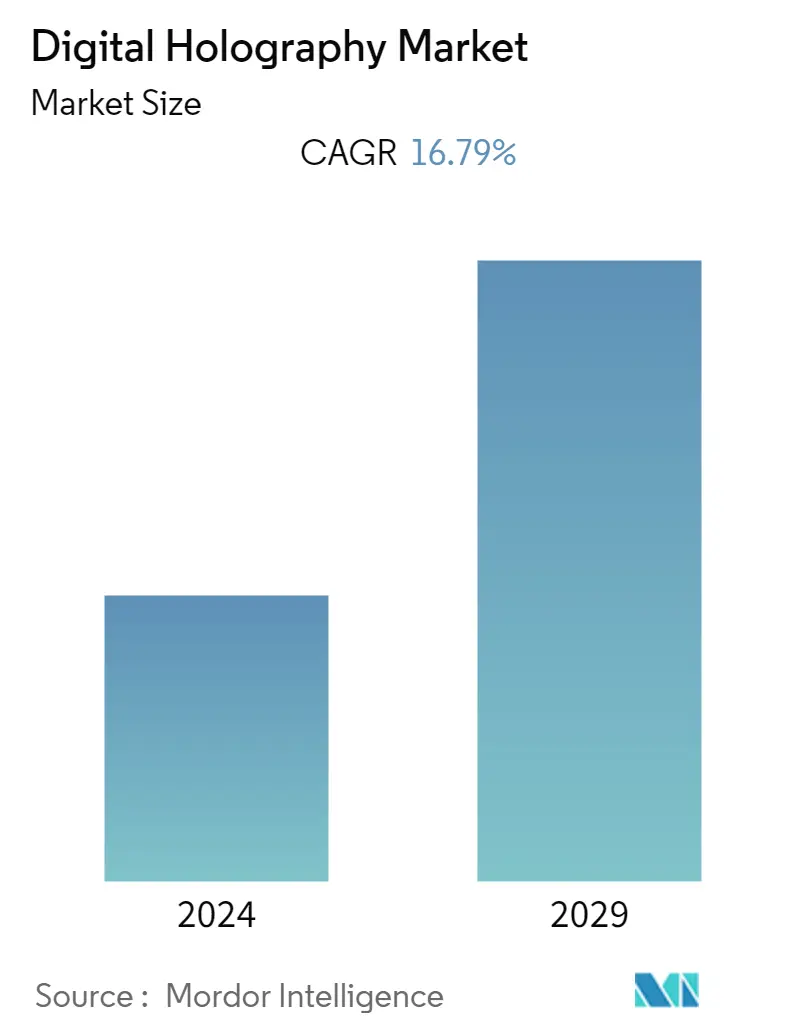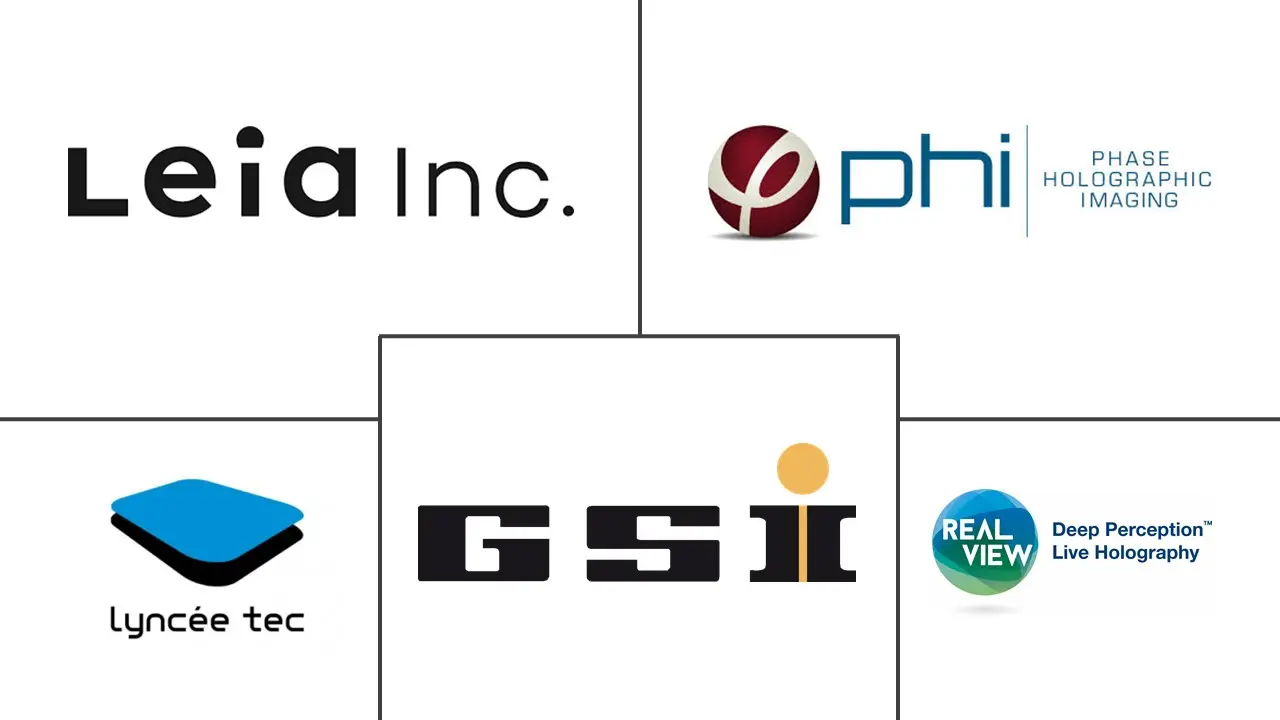Market Size of Digital Holography Industry

| Study Period | 2019 - 2029 |
| Base Year For Estimation | 2023 |
| CAGR | 16.79 % |
| Fastest Growing Market | Asia Pacific |
| Largest Market | North America |
| Market Concentration | Low |
Major Players
*Disclaimer: Major Players sorted in no particular order |
Digital Holography Market Analysis
The Digital Holography Market size is expected to grow from USD 4.92 billion in 2023 to USD 10.69 billion by 2028, at a CAGR of 16.79% during the forecast period (2023-2028).
Two waves are required to produce a hologram and simultaneously record quantitative phase and amplitude images in digital holography. Several application scenarios have demonstrated how this novel idea enables quick 3D imaging. Every industry, including real estate, healthcare, education, and retail, turns to the 3D world to get a more precise and accurate picture of their business models.
- Retailers can incorporate self-service kiosks where customers may engage with a holographic product, bringing an entirely new level of engagement that could ultimately result in greater sales to ensure a frictionless shopping experience. In Pennsylvania, Coen Markets opened two checkout-fee stores; with the aid of the Grabango app, customers may make payments without going through a checkout process.
- Holographic imaging technology boosts biomedical research, healthcare, life sciences, and medical education and training. To better prepare medical students, Cambridge University Hospitals (CHU) and the university's education faculty have introduced mixed reality. Students using Microsoft HoloLens mixed reality headsets can see each other in real-time while engaging with a multi-layered, medically accurate holographic patient thanks to an app that CUH and the university's faculty of education developed in collaboration with tech company GigXR.
- Adopting 3D holography from 2D involves significant expense due to the high cost of objective lenses and specialized digital imaging equipment requirements. Due to the higher computing costs associated with processing holograms, the approach also has a limited range of applications.
- Businesses became aware of the necessity of adopting the newest approaches during COVID-19 due to social estrangement, remote employment, and online education. This increased the need for AR and VR in numerous industries to provide users with a real-life experience. For gaming lovers, VividQ and Dispelix designed a holographic tech that can be used with AR headsets or smart glasses. Gamers can take part in immersive augmented reality experiences where digital content is displayed in the real environment for easy and comfortable interaction.
Digital Holography Industry Segmentation
A wavefront diffracted from an object is captured using the holographic technique. By applying the theory of light diffraction, a hologram can be used to rebuild a three-dimensional (3D) image. An object's wavefront is recorded on a digital hologram using the process known as "Digital Holography," and then a computer is used to reconstruct both quantitative phase pictures and 3D images of the object.
The Digital Holography Market is Segmented by Offering (Hardware and Software), Application (Digital Holographic Displays, Digital Holographic Microscopy, and Holographic Telepresence), End-user Vertical (Medical, Aerospace and Defense, Commercial, Education, Automation, and Other End-user Verticals), and Geography. The market sizes and forecasts are provided in terms of value (USD) for all the above segments.
| Offering | |
| Hardware (Beam Splitter, CCD Camera, Laser, and Others) | |
| Software |
| Application | |
| Digital Holographic Displays | |
| Digital Holographic Microscopy | |
| Holographic Telepresence |
| End-user Vertical | |
| Medical | |
| Aerospace and Defense | |
| Commercial | |
| Education | |
| Automation | |
| Other End-user Verticals |
| Geography | ||||||
| ||||||
| ||||||
| ||||||
| ||||||
|
Digital Holography Market Size Summary
The digital holography market is experiencing significant growth, driven by its applications across various industries such as healthcare, retail, education, and real estate. This technology enables quick 3D imaging by using two waves to produce holograms, capturing both phase and amplitude images digitally. In retail, for instance, holographic displays are enhancing customer engagement through self-service kiosks, while in healthcare, institutions like Cambridge University Hospitals are utilizing mixed reality to improve medical training. The technology's ability to create immersive experiences is also being leveraged in gaming and marketing, with companies like VividQ and Dispelix developing holographic tech for AR headsets, and digital signage solutions offering content without headgear restrictions. Despite its high cost and limited range of applications due to the need for specialized equipment, the demand for digital holography is growing, particularly as industries adapt to new technologies post-COVID-19.
The Asia-Pacific region is leading the adoption of digital holography, with countries like Japan and Singapore implementing advanced holographic displays and digital twins to enhance consumer experiences. The market is highly fragmented, with numerous competitors investing in research and development to maintain their competitive edge. Innovations such as Looking Glass's large holographic displays and PORTL's intelligent home mirrors are pushing the boundaries of what holography can achieve. Collaborations and funding, like that between Accenture and Looking Glass, are further accelerating the transition from 2D to 3D technologies. The market's growth is also supported by advancements in related fields, such as augmented reality and 5G, which are expected to reshape industries like travel and tourism by offering immersive virtual experiences.
Digital Holography Market Size - Table of Contents
-
1. MARKET DYNAMICS
-
1.1 Market Overview
-
1.2 Market Drivers
-
1.3 Market Restraints
-
1.4 Industry Value Chain Analysis
-
1.5 Porter's Five Forces Analysis
-
1.5.1 Threat of New Entrants
-
1.5.2 Bargaining Power of Buyers/Consumers
-
1.5.3 Bargaining Power of Suppliers
-
1.5.4 Threat of Substitute Products
-
1.5.5 Intensity of Competitive Rivalry
-
-
1.6 Assessment of Impact of COVID-19 on the Industry
-
-
2. MARKET SEGMENTATION
-
2.1 Offering
-
2.1.1 Hardware (Beam Splitter, CCD Camera, Laser, and Others)
-
2.1.2 Software
-
-
2.2 Application
-
2.2.1 Digital Holographic Displays
-
2.2.2 Digital Holographic Microscopy
-
2.2.3 Holographic Telepresence
-
-
2.3 End-user Vertical
-
2.3.1 Medical
-
2.3.2 Aerospace and Defense
-
2.3.3 Commercial
-
2.3.4 Education
-
2.3.5 Automation
-
2.3.6 Other End-user Verticals
-
-
2.4 Geography
-
2.4.1 North America
-
2.4.1.1 United States
-
2.4.1.2 Canada
-
-
2.4.2 Europe
-
2.4.2.1 Germany
-
2.4.2.2 United Kingdom
-
2.4.2.3 France
-
2.4.2.4 Rest of Europe
-
-
2.4.3 Asia-Pacific
-
2.4.3.1 India
-
2.4.3.2 China
-
2.4.3.3 Japan
-
2.4.3.4 Rest of Asia-Pacific
-
-
2.4.4 Latin America
-
2.4.4.1 Brazil
-
2.4.4.2 Argentina
-
2.4.4.3 Rest of Latin America
-
-
2.4.5 Middle-East and Africa
-
2.4.5.1 United Arab Emirates
-
2.4.5.2 Saudi Arabia
-
2.4.5.3 Rest of Middle-East and Africa
-
-
-
Digital Holography Market Size FAQs
What is the current Digital Holography Market size?
The Digital Holography Market is projected to register a CAGR of 16.79% during the forecast period (2024-2029)
Who are the key players in Digital Holography Market?
RealView Imaging Ltd., Lyncee TEC SA, Phase Holographic Imaging AB, Geola Digital Uab and Leia Inc are the major companies operating in the Digital Holography Market.

